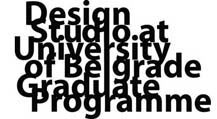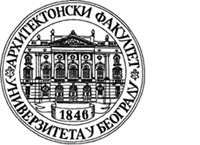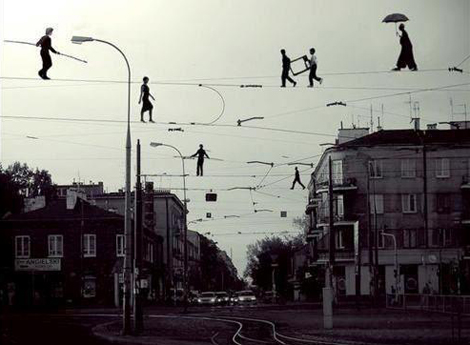After Geometry: Technology and Ecology in Architecture
Module: Seminar M6.2 2012/13, 3 ECTS
Djordje Stojanovic and Milutin Cerovic
Graduate Programme, Faculty of Architecture – University of Belgrade
This is a seminar open to students at the final year of their studies at University of Belgrade. The course aims to introduce a broad spectrum of topics related to two disciplinary fields, technology and ecology in relation to contemporary architectural practice and research. Throughout the semester we will seek to establish common ground between the technological and ecological phenomena, and look at what implications such association might have on architecture. We will be exploring benefits arising from their convergence and will discuss how they can be integrated into design strategies. Moreover we will debate whether or not combined consideration of technology and ecology in architecture may offer design route which is not necessarily based on geometric understanding of space. The course will provide insight on how to:
• understand ongoing changes in contemporary architectural practice and research, based on increasing importance of technological and ecological aspects
• expand the scope of architectural design to include wider range technological and ecological aspects
• develop design intent according to the environmental problems
• development of the critical understanding of strategies for the efficient use of energy sources
• consider the means for the improved integration between social, natural and built structures
• build theoretical platform for the design related work
• understand the need for research oriented practice in architectural design
The agenda of this course will relate to other existing courses dealing with one of the two identified disciplinary fields, which students might have taken during the first year of their graduate studies. At the same time the course will take a critical stance with an aim to question and/or establish common territory between technological and ecological aspects within architectural design. For instance, use of clean energy sources or formation of energy efficiency strategies will be considered only as an integral part of the design intent for any given project. Throughout the debate, the idea of sustainable development will be related to the intertwining of social, natural and built structures. In a series of lectures and discussions, we will try to establish relations between built environment and natural systems, and develop the understanding of architecture as truly ecological discipline. We will try to provide answers to the question if the relevance of technology and ecology is the consequence of the cause of broader cultural, social, economic, and institutional shifts.
The course will unfold through the series of lectures, video projections, debates, group work and short exercises, of which the most will be based on the case studies and analysis of projects differing in scale. List of invited speakers includes: Cristina Díaz Moreno & Efrén García Grinda (Cero9), prof. Branko Kolarević (Associate Dean, University of Calgary – Integrated Design, Architecture Faculty, Design Theory, Digital Design and Fabrication), prof. Ljiljana Blagojević, prof. Ružica Božović Stamnović, prof. Aleksandra Stupar, prof. Ivan Kucina, Soomeen Hahm & Igor Pantic (Zaha Hadid Architects) and Milica Milojević. Video projections will include talks by Philippe Rahm, Sean Lally, Enric Ruiz-Geli (Cloud9), Marcos Cruz, Phillip Beesley, Rachel Armstrong, Lucy McRae and Suzanne Lee.
Modul M6.2 Seminar, 2 ESPB
Nakon geometrije – ekologija i tehnologija u arhitekturi
doc. Djordje Stojanović, ass. Milutin Cerović
Master akademske studije – Arhitektonski fakultet Univerziteta u Beogradu
Programski okvir seminara čine dve oblasti, tehnologija i ekologija. Cilj kursa je upoznavanje studenta sa širokim spektrom tema iz ovih oblasti i sticanje znanja u formiranju relevantnih projektantskih pozicija u savremenoj praksi i istraživačkom radu. Tokom semestra bavićemo se uspostavljanjem odnosa između tehnoloških i ekoloških fenomena, kao i analizom implikacija koje taj odnos ima na arhitekturu. Istraživaćemo potencijale koji nastaju usled njihovog međusobnog preplitanja, a potom diskutovati o problemima koncepcije i realizacije arhitektonskih projekata koji se zasnivaju upravo na takim mogućnostima umesto na tradicionalno prihvaćenom geometrijskom pristupu organizacije prostora. Tokom kursa studenti mogu steći saznanja koja se odnose na:
• sagledavanje promena koje nastaju u savremenoj arhitektonskoj praksi usled izmenjenog značaja tehnoloških i ekoloških aspekata u arhitektonskom projektovanju
• proširivanje polja delovanja u arhitektonskom projektovanju kroz uključivanje tehnoloških i ekoloških strategija
• razvijanje projektantskog stava i kritičkog odnosa prema savremenim problemima ugroženosti životne sredine i normama energetske efikasnosti
• razmatranje mogućnosti boljeg povezivanja socioloških, prirodnih i izgrađenih struktura
• stvaranje teorijske platforme za projektantski rad
• razumevanje uloge istraživački orijentisanog projektovanja i potrebe za zauzimanjem progresivne pozicije u arhitektonskom projektovanju
Seminar se nadovezuje na značajan broj postojećih nastavnih jedinca u okviru Master akademskih studija koje se bave jednom od ove dve oblasti, ali istovremeno zauzima kritički stav u cilju preispitivanja i tumačenja zajedničke uloge tehnologije i ekologije u savremenim strategijama arhitektonskog projektovanja. Na primer, eksploatacija čistih izvora energije ili formiranje plana za energetsku efikasnost nekog objekta biće razmatrane u sprezi sa ukupnom projektantskom strategijom tog objekta. Pojam održivog biće vezan za mogućnost prožimanja socioloških, prirodnih i izgrađenih struktura. Kroz niz predavanja i diskusija, pokušaćemo da uspostavimo odnose između izgrađenog okruženja i prirodnih sistema, i tako razvijemo razumevanje arhitektonskog projektovanja kao suštinski ekološke discipline. Pokušaćemo da odgovorimo na pitanje da li je značaj koji tehnologija i ekologija nose, posledica ili uzrok širih kulturoloških, socioloških, ekonomskih i političkih pomeranja.
Kurs će se u zavisnosti od broja studenata odvijati u vidu serije izlaganja gostujućih predavača, video projekcija, debata, grupnog rada i praktičnih vežbi. Nastave će se zasnivati na studijama slučaja i pregledu relevantnih projekata čije dimenzije variraju od najmanjih do najvećih. Na listi pozvanih predavača su: Cristina Díaz Moreno & Efrén García Grinda (Cero9), prof. Branko Kolarević (Associate Dean, University of Calgary – Integrated Design, Architecture Faculty, Design Theory, Digital Design and Fabrication), prof. Ljiljana Blagojević, prof. Ružica Božović Stamnović, prof. Aleksandra Stupar, doc. Ivan Kucina, Soomeen Hahm & Igor Pantic (Zaha Hadid Architects) i Milica Milojević. Na listi predavača čija predavanja će biti prikazana putem video projekcija su: Philippe Rahm, Sean Lally, Enric Ruiz-Geli (Cloud9), Marcos Cruz, Phillip Beesley, Rachel Armstrong, Lucy McRae i Suzanne Lee.
Image credit: Florian Gaité
Reading List
- Reyner Banham, Architecture of Well Tempered Environment, Second, Revised Edition. Architectural Press. 1984
- Blagoljević Lj., Ćorović D. Klimatske promene i estetika savremene arhitekture(pdf)
- Guattari, Felix. The three ecologies(pdf)
Video
- *Philippe Rahm, Constructed Atmospheres, ETH Zurich, 2009.
- Sean Lally, The Air on other Planets, Princeton Recordings, 2012.
- Cloud9 Enric Ruiz Geli, Media – ICT building, AA London, 2011.
- Marcos Cruz, Living Buildings – Architecture’s Path to Ecology, TEDx UCL, 2012.
- Phillip Beesley, Building living architecture, TEDx UW, 2012.
Video optional
- Philippe Rahm (curator), Constructed Atmospheres Lecture Series, Princeton Recordings, 2012.
- Mette Thomsen, A Sensitive Architecture: Designing for a Materially Graded Architecture, ETH Zurich CAAD, 2011.
- Karmen Franinovic, Beyond Kinetic Architecture: from movable structures to vibrant matter, ETH Zurich CAAD, 2011.
- Philip Beesley, Diffusive Architecture, SCI-Arc LA, 2011.
- Marcos Cruz, Neoplasmatic Architecture, University of Michigan, 2012.
- Michael Weinstock, Metabolism of the City, AA London, 2010.
- Julian Vincent, Influences of biology on architecture, IaaC Barcelona, 2012.



